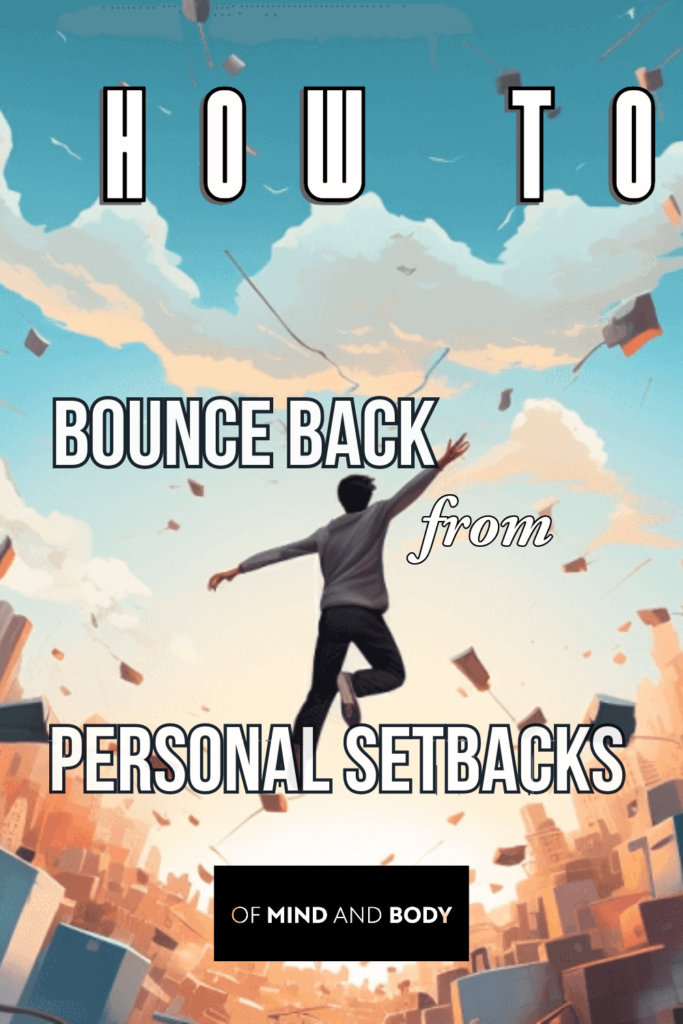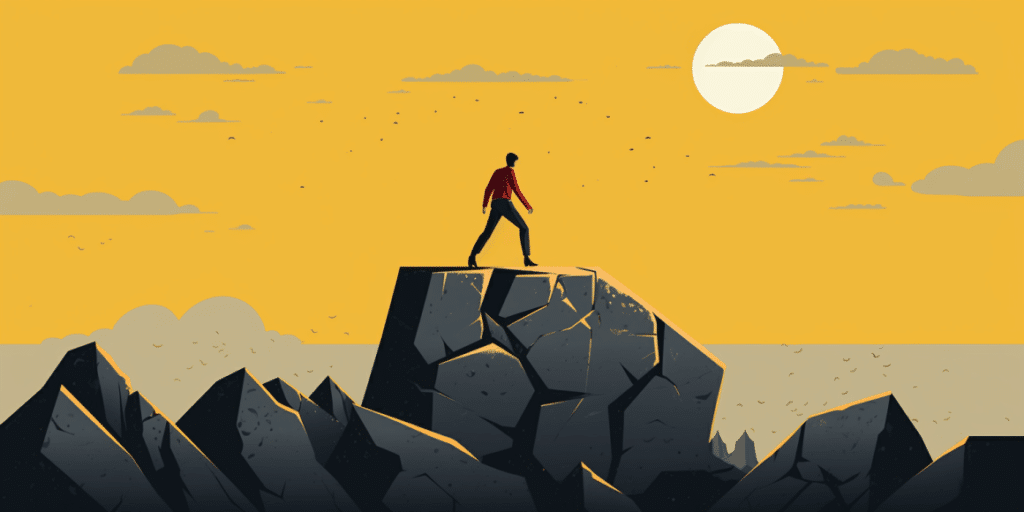
The Inevitability of Life’s Storms
Every person, no matter the path they tread, will inevitably face setbacks. From missing a crucial deadline at work, experiencing a falling out with a close friend, to facing health challenges or even missing the morning bus, these moments, though often seen as mere inconveniences or obstacles, are in reality transformative junctures. They serve as defining instances. Such challenges compel us to introspect, recalibrate, and emerge stronger, wiser, and more resilient. Importantly, in the face of these setbacks, we are presented with a choice: to react with despair or determination, to see them as insurmountable barriers or invaluable lessons. The power to decide, to learn and grow, or to remain stagnant, ultimately rests with us.

Understanding the Essence of Resilience
Resilience, a term that resonates with strength and adaptability, finds its roots in the ancient teachings of Stoic philosophy. For the Stoics, life’s challenges were not to be feared or avoided but embraced as essential components of human growth. They believed that adversity, when approached with the right mindset, could be transformed into an opportunity for personal evolution.
Fast forward to today, and the concept of resilience has taken on an even broader and more profound meaning. In our fast-paced, ever-changing world, resilience is no longer just about weathering the storm or bouncing back from a setback. It’s about taking that storm, understanding its nature, and using its force to propel oneself forward. It’s about viewing adversity not as a roadblock but as raw material, ready to be moulded into a foundation for future success.
Resilient individuals shape their experiences, even the challenging ones, into lessons and stepping stones. They harness the energy of setbacks, channelling it into motivation and determination, allowing them to ascend to greater heights than they might have without such challenges.
Furthermore, resilience in the modern age is also about flexibility and adaptability. In a world where change is the only constant, the ability to pivot, to change direction when faced with obstacles, and to find new ways to overcome challenges is invaluable. It’s a skill, a mindset, and a philosophy, all rolled into one, guiding individuals to not just survive, but thrive amidst life’s complexities.
The Mindful Approach to Setbacks

In the tumultuous aftermath of a setback, our minds often become a whirlwind of regrets and “what ifs.” We might find ourselves ruminating on past decisions, wondering where we went wrong, or feeling apprehensive about the uncertainties that the future might hold. This mental chaos not only amplifies our distress but also clouds our judgement, making it challenging to find a way forward.
Yet, amidst this storm, there exists a sanctuary: the present moment. Mindfulness, the practice of being fully engaged in the here and now, offers a respite from the relentless tug of past regrets and future anxieties. By grounding ourselves in the present, we create a space where we can observe our thoughts and emotions without judgement. It’s akin to finding a still point in a turning world.
When we adopt a mindful approach to setbacks, several transformative things occur:
1. Heightened Self-awareness
By focusing on the present, we become acutely aware of our internal landscape. We begin to recognise patterns in our reactions, understand the triggers that exacerbate our distress, and discern the difference between our genuine feelings and the stories we tell ourselves.
2. Emotional Regulation
Mindfulness equips us with the tools to navigate our emotions rather than being overwhelmed by them. By observing our feelings without attachment, we can process them more effectively, allowing for healing and clarity.
3. Clarity of Thought
With the noise of regret and apprehension muted, our minds become clearer. We can objectively analyse the setback, understanding its causes and implications, and strategise a way forward.
4. Enhanced Resilience
Over time, a mindful approach to challenges fosters resilience. We become adept at facing setbacks head-on, drawing from them invaluable lessons and using them as stepping stones for future growth.
5. Connection with Core Values
Grounding ourselves in the present also reconnects us with our core values and beliefs. This connection acts as a compass, guiding our reactions and decisions in alignment with our true selves.
In essence, while setbacks are an inevitable part of life’s journey, mindfulness offers a lens through which we can view them not as insurmountable obstacles but as opportunities for introspection, growth, and transformation.
The Stoic’s Guide to Navigating Setbacks

Stoicism, a philosophical gem from ancient Greece and Rome, remains as relevant today as it was millennia ago. Rooted in the teachings of thinkers like Epictetus, Seneca, and Marcus Aurelius, this philosophy provides a robust framework for navigating the tumultuous seas of life.
At the heart of Stoicism lies a simple yet profound truth: while the world around us, with its unpredictable events and external pressures, is often beyond our control, our internal world—our thoughts, emotions, and reactions—is a domain we can govern.
Consider the everyday setbacks: a sudden downpour when you’ve forgotten your umbrella, a critical email from a boss, or an unexpected bill. A Stoic approach doesn’t deny the frustration or disappointment of these moments. Instead, it offers a perspective shift. It asks: “What can I control?” The answer, invariably, is our response. We can’t stop the rain, but we can choose to carry on without complaint. We can’t prevent criticism, but we can decide how to process and act on it.
Internalising Stoic values is akin to equipping oneself with an inner compass. This compass doesn’t eliminate life’s storms, but it provides direction, ensuring we remain steady and purposeful amidst the chaos. It teaches us the value of equanimity, urging us to maintain a balanced mind regardless of external circumstances.
Furthermore, Stoicism places a strong emphasis on virtue and character. It suggests that true contentment doesn’t stem from external achievements or possessions but from cultivating an impeccable character. In the face of setbacks, this focus on inner virtue becomes a beacon, guiding us towards actions and reactions that align with our highest self.
In essence, Stoicism offers more than just a coping mechanism; it provides a road map to a life of purpose, resilience, and inner peace. By embracing its teachings, we not only navigate setbacks with grace but also find serenity in chaos and discover purpose in the seemingly aimless wanderings of life.
Harnessing the Power of Cognitive Behavioural Therapy (CBT)

At its core, CBT is about empowerment. It arms individuals with a toolkit of strategies and exercises designed to dissect and challenge maladaptive thought patterns. For instance, if one often thinks, “I always fail at everything I do,” CBT would encourage questioning this belief, seeking evidence, and eventually reframing it to a more balanced perspective like, “I have faced challenges, but I’ve also had successes.“
Moreover, CBT emphasises the transient nature of setbacks. Instead of viewing them as permanent roadblocks, it encourages a perspective shift, seeing them as temporary hurdles that provide invaluable lessons. This shift is crucial, for it transforms challenges into catalysts for introspection, resilience–building, and personal evolution.
Furthermore, CBT is not a passive process. It demands active participation, consistent reflection, and a willingness to confront deeply ingrained beliefs. Through techniques like journaling, role–playing, and guided imagery, individuals learn to replace detrimental thought patterns with constructive ones, fostering a mindset that not only copes with adversity but thrives in its midst.
In essence, CBT is a transformative journey. It’s a voyage from the tumultuous seas of cognitive distortions to the serene shores of mental clarity, where setbacks are no longer daunting giants but stepping stones leading to greater self–awareness and growth.
1. Thought Records
This technique involves keeping a diary of negative thoughts or self-talk that arise during setbacks. By writing down these thoughts, individuals can objectively analyse them, challenge their validity, and reframe them into more positive or realistic statements. For instance, changing “I always mess up” to “I made a mistake this time, but I can learn and improve.“
2. Behavioural Experiments
These are controlled experiences set up to challenge negative beliefs or fears stemming from setbacks. For example, if someone believes they’re terrible at public speaking due to a past failure, they might start by speaking in front of a small, supportive group to test and gradually challenge this belief.
3. Socratic Questioning
This involves asking oneself a series of probing questions to challenge negative beliefs related to setbacks. Questions like “What evidence do I have that supports or contradicts this belief?” or “Are there alternative explanations or viewpoints I haven’t considered?” can help break the cycle of negative thought patterns.
4. Cognitive Restructuring
This technique focuses on identifying and disputing irrational or maladaptive thoughts known as cognitive distortions (e.g., overgeneralization, catastrophizing). After a setback, you might think, “This always happens to me.” Cognitive restructuring would involve breaking down this thought, examining its truth, and reshaping it to something like, “I’ve faced challenges before, but I’ve also overcome many of them.“
5. Guided Discovery
Here, individuals are encouraged to look at their setbacks and beliefs from a fresh perspective. By exploring and reflecting on specific questions posed by a therapist or through self-help tools, they can discover new insights about their patterns of thinking and behaving, leading to a more balanced view of setbacks.
Each of these techniques, when applied consistently, can greatly aid in transforming your perception of setbacks from insurmountable obstacles to opportunities for growth and learning.
Further Techniques for Overcoming Setbacks

Life’s journey is punctuated with challenges and setbacks. However, the way we respond to these obstacles can significantly influence our personal growth and well-being. Here’s a compilation of techniques that can guide you in navigating through setbacks and emerging stronger:
1. Embracing Failure as a Stepping Stone
Every setback, every failure, holds a lesson. Instead of viewing these moments as defeats, see them as opportunities for growth and learning. History is replete with luminaries who used their failures as springboards to greater success. By reframing setbacks as stepping stones, we can transform adversity into advantage.
2. The Role of Self-compassion in Recovery
In the aftermath of a setback, it’s natural to be hard on yourself. However, practising self–compassion can be a healing balm. By treating ourselves with the same kindness and understanding as we would a dear friend, we create a nurturing environment where recovery and growth can flourish.
3. Cultivating a Growth Mindset
A growth mindset, as proposed by psychologist Carol Dweck, is the belief that abilities and intelligence can be developed through dedication and hard work. By adopting this mindset, challenges become opportunities to grow, and setbacks become part of the learning curve, not insurmountable obstacles.
4. The Art of Letting Go
Holding onto past failures and disappointments can weigh us down. The art of letting go involves releasing these negative emotions and experiences, allowing us to move forward unburdened. By shedding the weight of past setbacks, we make room for new opportunities and experiences.
5. Celebrating Small Wins on the Road to Recovery
Recovery and growth are often gradual processes. By recognising and celebrating small victories along the way, we reinforce positive behaviours and boost our morale. Every step forward, no matter how minor, is progress worth acknowledging.
6. The Future: Preparing for Setbacks
While we cannot predict every challenge that lies ahead, we can prepare ourselves mentally and emotionally for future setbacks. This involves cultivating resilience, equipping ourselves with coping strategies, and maintaining a positive, proactive mindset. By anticipating and preparing for challenges, we position ourselves to navigate them with grace and confidence.
By integrating these techniques into our lives, we not only equip ourselves to overcome setbacks but also pave the way for personal growth, resilience, and long-term well-being.
Conclusion: The Triad of Triumph Over Setbacks

In the intricate dance of life, setbacks are inevitable, but they need not define our journey. The ancient wisdom of Stoicism teaches us the art of acceptance and the power of perspective, reminding us that while we cannot control external events, our internal reactions are ours to command. Mindfulness, on the other hand, anchors us in the present, allowing us to approach challenges with clarity, presence, and equanimity. Meanwhile, Cognitive Behavioural Therapy (CBT) equips us with tangible tools to dissect and reshape our thought patterns, transforming setbacks from daunting obstacles into opportunities for growth.
When combined, these three pillars—Stoicism, Mindfulness, and CBT—form a formidable roadmap for navigating life’s challenges. They provide a holistic approach to setbacks, ensuring that we not only bounce back but also grow stronger, wiser, and more resilient in the process. By embracing and integrating these principles, we empower ourselves to turn life’s storms into stepping stones, charting a path of continuous growth, understanding, and profound personal evolution.



